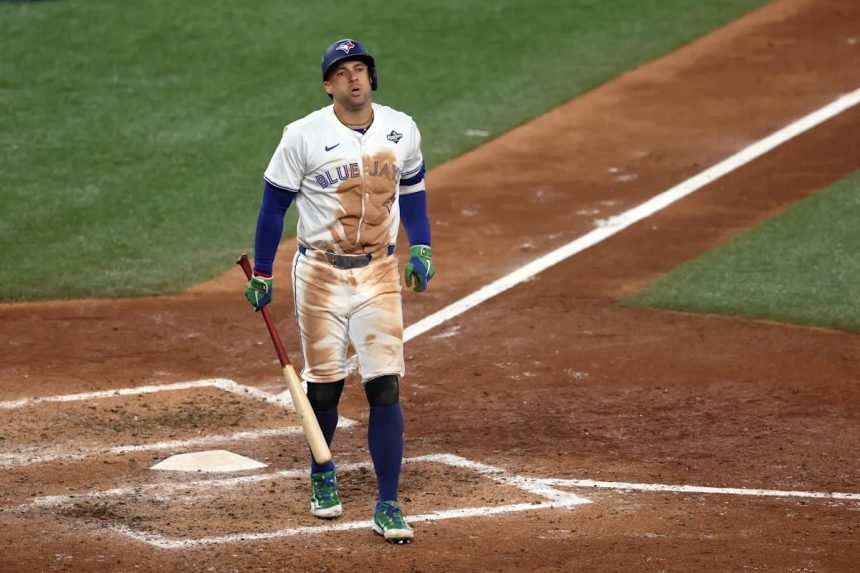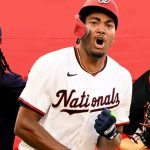TORONTO — Time and time again during their prolific postseason run, the Toronto Blue Jays have sent pitcher after pitcher back to the opposing dugout, defeated, frustrated and thoroughly exhausted from the task of slowing down the relentless efforts of Toronto’s lineup.
Not this time. Not this pitcher. In Game 2 of the World Series, the Blue Jays’ bats met their match.
Advertisement
Amidst a historically productive October at the plate, Toronto’s offense was silenced on Saturday, as Dodgers right-hander Yoshinobu Yamamoto pitched a 105-pitch complete game to help L.A. even the World Series at one game apiece with a 5-1 victory. It was Yamamoto’s second straight complete game, following his masterpiece against the Brewers in the NLCS, making him the first pitcher to hurl consecutive complete games in the postseason since Curt Schilling in 2001.
While the Blue Jays ramped up Yamamoto’s pitch count in the early frames, converting opportunities into runs was a struggle. Yamamoto threw 23 pitches in the first inning but escaped a first-and-third, no-out situation unscathed. Ernie Clement reached to lead off the second inning when Freddie Freeman completely whiffed on an infield pop-up, but nine pitches later, Yamamoto was heading back to the dugout with another zero on the scoreboard. A wayward sinker plunked George Springer to lead off the third, and Springer eventually scored on a sacrifice fly from Alejandro Kirk to tie the game 1-1.
But Springer touching home was the final time the Rogers Centre crowd would cheer during the bottom half of an inning. Afforded a late lead by solo homers from Will Smith and Max Muncy against Blue Jays starter Kevin Gausman, Yamamoto got stronger as the contest went on. He retired the final 20 hitters he faced, putting the finishing touches on his night by getting Daulton Varsho to pop out for the 27th out.
“He was that good,” manager John Schneider said. “Got his 23 pitches in the first. … That was probably our best chance. First and third, and nobody out. After that, it was kind of few and far between. Second complete game in a row in the postseason — that’s pretty impressive, with a layoff in between. I think he made it hard for us to make him work.”
Yamamoto’s gem served in stark contrast to how his fellow star starter, Blake Snell, fared 24 hours earlier, when the left-hander was tagged for five runs in what snowballed into an 11-4 rout in Game 1. Toronto was looking to keep riding the wave at the plate in Game 2, and based on how the Blue Jays had been swinging it this month, there was little reason to doubt their ability to do so. Entering Saturday, Toronto was averaging 6.8 runs per game with a .900 OPS, both tied with the 1999 Red Sox for second all-time among teams to play at least 10 games in a single postseason. And it hasn’t just been a select few sluggers driving the bus: Eight Toronto hitters have driven in at least eight runs this postseason, which is an MLB record.
Advertisement
But Yamamoto presented a different kind of challenge, even before it became apparent that the right-hander had the stuff to deliver one of the best World Series starts in recent memory. The Blue Jays had zero history against Yamamoto, as they did not see him during their series at Dodger Stadium in August or when the Dodgers visited Toronto in April 2024. Only two hitters on Toronto’s active roster had ever faced Yamamoto: Second baseman Isiah Kiner-Falefa went 1-2 with a strikeout against Yamamoto as a Pirate in April, and bench bat Ty France walked and struck out against him as a Twin in July.
For the rest of the Blue Jays’ lineup, Saturday represented their first look at a uniquely talented hurler who has emphatically shown the past two seasons why the Dodgers were willing to give him $325 million before he had thrown a pitch in the major leagues. It turned out to be quite the first impression, with a dominant display in Game 2 that introduced Toronto to what makes Yamamoto capable of vexing the best hitters on the planet.
“It’s a funky delivery, for sure,” Schneider said. “Like everyone, you do a lot of work to get ready for it. … They were ready. I think that you just give him credit. He tunneled everything really well, held his velo, spotted his heater really well. I don’t think it was for a lack of prep — it’s deception. There’s definitely some deception in the delivery, too. He was on his game.”
In addition to his precise command of six dynamic, distinct pitches, Yamamoto presents an unusual look before his offerings arrive in and around the strike zone. His delivery features a precise sequence of movements that includes one unique moment in particular: As his left leg is fully raised and his hands break before he fires a pitch, Yamamoto’s head briefly turns to face away from home plate, toward third base, before he recenters toward his target and explodes down the mound with force. This subtle head turn mixed into his carefully constructed mechanics makes the whole operation more challenging to pick up and time from the batter’s box — and that’s before his pitches start dancing in all directions on their journey to home plate.
Advertisement
“The first two at-bats, I found myself, like, following his eyes,” said Clement, who was hitting .435 this postseason before his first battle with Yamamoto. “It was really weird. Instead of picking up the release point, like, I found myself kind of looking at his face, which kind of just had me not really seeing the ball. It kind of threw me off a little bit. … He’s as good as it gets.”
“He had all his pitches working for him,” left fielder Nathan Lukes said. “He’s one of the best for a reason, and he showed it.”
“He’s one of the top pitchers in the league,” said Vladimir Guerrero Jr., who was fooled uncharacteristically badly on a curveball in the first inning, recording just his fourth strikeout of this postseason. “It was the first time that we faced him, and he did an excellent job.”
Perhaps these first encounters with Yamamoto will benefit the Blue Jays’ hitters later in the series in a pivotal rematch. But for now, they must turn their focus to Game 3 as the tied World Series heads to Los Angeles.
Advertisement
“You get some feedback and hopefully make some adjustments,” Schneider said. “But really, I think right now, you’re worried about [Tyler] Glasnow, Game 3. But I think we do a really good job of making adjustments as we see guys.”
There’s reason for optimism that Toronto’s bats can heat back up in short order, perhaps in tandem with the warmer outdoor setting of Dodger Stadium, which has played as notably hitter-friendly this season. The Blue Jays proved just last round that they can rally; they logged quiet offensive showings at home against the Mariners in the ALCS before returning to their high-scoring ways once they hit the road.
And while Glasnow is yet another talented Dodgers pitcher for Toronto to face, he will not wield the same level of novelty that Yamamoto did; the Jays’ lineup has faced him on multiple occasions in recent years, including earlier this season. Shohei Ohtani looms in Game 4, but he, too, has faced several key Blue Jays hitters numerous times, even if he hasn’t made a start against Toronto since 2022. Ultimately, if the past month is any indication, it’s more likely that Game 2 ends up being an outlier for this offense than the start of a lengthy scuffle.
But arguably even more important than how the Blue Jays’ bats bounce back will be what happens on the other side of the ball in Game 3, when 41-year-old Max Scherzer will make his 27th career postseason start — and fifth in the World Series. It will make Toronto the fourth team Scherzer has pitched for in the Fall Classic, a staggering statistic exemplifying the magnitude and duration of his legendary career.
Advertisement
An injury-marred regular season that ended with a particularly poor showing in September made it tough to feel too confident about Scherzer’s ability to meaningfully contribute in October, but his stellar outing in ALCS Game 4 reminded everyone that the future Hall of Famer features an unrivaled competitive streak and still has more to give. Monday in Los Angeles will bring Scherzer at least one more opportunity to demonstrate his greatness and regain the edge for Toronto in this series.
“I can’t wait for him to take the mound,” Guerrero said Saturday. “He’s gonna give all he has.”











